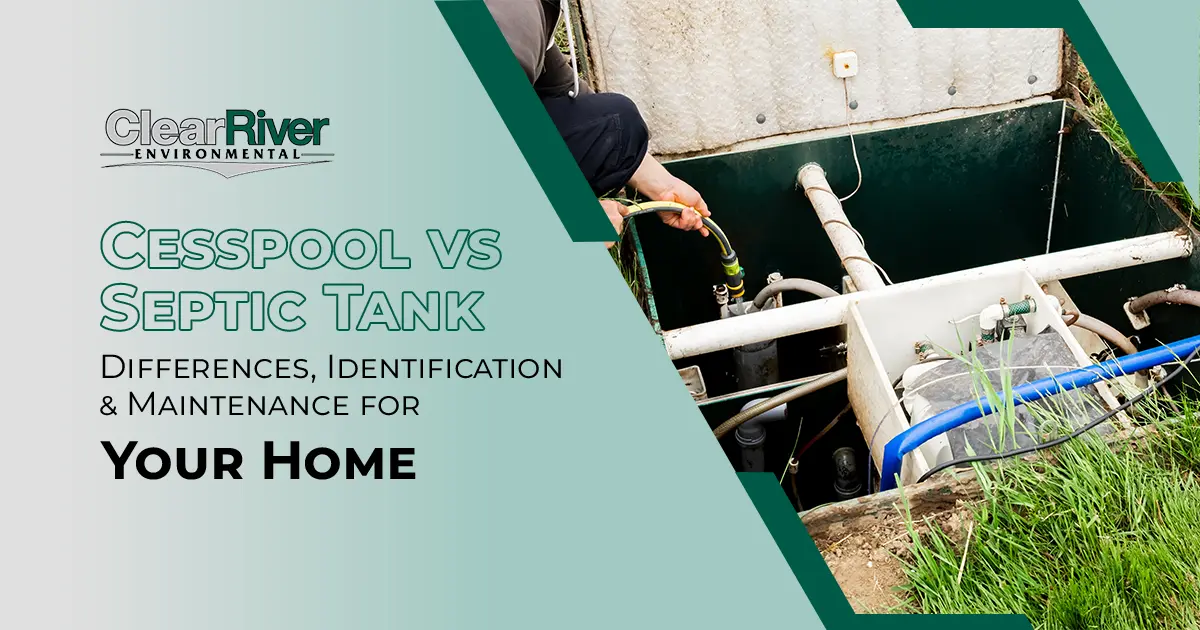Cesspool vs. Septic Tank: Differences, Identification & Maintenance for Your Home
- David Warren
- August 4, 2025

Mistakes with your home’s wastewater system can get pricey, messy, not mention risky for your health! Many homeowners confuse what is a cesspool, what does cesspool mean, and how to tell the difference between a cesspool and a septic tank. Missing warning signs or skipping maintenance can lead to backups, legal issues, or problems when selling your home.
Understanding what is a cesspool sewer & how it works, along with the basics of a septic tank, helps protect your comfort and property value. This guide answers “how do I know if I have a cesspool or septic tank?” and offers practical steps for care.
In This Article
Long Island Spotlight: Why Cesspools & Septic Tanks Still Matter
If you live on Long Island, your wastewater story is different from much of the country. Roughly threequarters of Suffolk County is still unsewered, and about 360,000 homes rely on aging Suffolk County cesspools or conventional septic systems. All of that sits above a single, solesource aquifer that supplies drinking water to more than 2.8 million people.
Understanding the Systems
Not all home wastewater setups are the same. Some properties use cesspool systems,
while many have septic tanks. Knowing what is the difference between a cesspool and
a septic tank, and what each requires, can save you time and money as a local Long
Island homeowner. Let’s deep dive into it then!
Long Island’s History with Septic Tanks & Cesspools:
- Pre1970s: Rapid suburban growth outpaced sewer expansion; simple cesspools
were the norm outside sewer districts. - 1973: Suffolk County banned cesspools in new construction and began requiring
septic tanks, but homeowners could still replace an old cesspool with another
cesspool. suffolkcountyny.gov - 2016 and beyond: Suffolk adopted Article 19 to test and approve
nitrogenreducing, “innovative/alternative” (I/A) septic systems. Nassau County
considers I/A systems a viable, costeffective alternative in unsewered areas.
eastendbeacon.com nassauswcd.org - Today: 74% of Suffolk remains unsewered; roughly 70% of the nitrogen in local
bays is traced back to those 360,000 cesspools and septic systems. lirpc.org - https://www.pinebarrens.org/suffolk-officials-unveil-4-billion-plan-to-fight-nitrogen-
pollution-in-surface-waters%20h
What Is a Cesspool you might ask?
A cesspool, also called a cesspool sewer, is a simple underground pit for wastewater. If
you’re wondering, “what does a cesspool look like?”—it’s often a round or rectangular
stone or concrete-lined hole with a cover. Wastewater flows in, solids sink, and liquid
seeps into the soil.
Environmental and Health Concerns
Cesspools pose risks like groundwater contamination because they don’t treat
wastewater thoroughly. They can leak harmful bacteria & chemicals into nearby water
sources. They also produce foul odors and attract pests like flies and rats, making them
a health hazard. Regular Inspections and replacing cesspools (if required) can help
prevent these issues.
Common cesspool questions answered:
- What is a cesspool system? A system made of a pit that collects and holds sewage. It relies on soil absorption.
- How does a cesspool work? Water and waste from your home enter the pit. Liquids seep out through the walls; solids collect on the bottom.
- How long does a cesspool last? Many work for 20-40 years but can fail early if overloaded or not maintained.
- How often should a cesspool be pumped? Yearly is common, but needs vary based on use and size.
Where you’ll find cesspools:
- Older homes (especially rural)
- Homes where codes have not yet required upgrades
Cesspool issues:
- Can pollute wells or streams
- Require frequent pumping
- Are illegal or restricted in some areas due to health risks
What Is a Septic Tank?
A septic tank is an improved system for handling household sewage. If you’ve compared what is a cesspool to a septic tank, here’s how they are different:
- A septic tank is watertight, made of concrete, plastic, or fiberglass
- Solids settle and bacteria break down waste; liquids flow to a drain field
- Easier and safer to maintain, with lower risk of pollution
What Is the Difference Between a Cesspool and a Septic Tank?
If you’re asking, “What is the difference between a cesspool and a septic tank?”—the main things to look at are:
- Treatment: Cesspools release untreated liquids into the ground; septic tanks treat wastewater before it leaves the system
- Lifespan: Septic tanks tend to last longer and need pumping every 2-5 years; cesspools need more frequent care
- Legal status: Septic tanks are standard in most new homes and are safer
How Do I Know If I Have a Cesspool or Septic Tank?
Spotting what kind of system you have is the sorcerer’s stone to the problem! If you’re unsure, use these pro-tips:
- Check for an old stone or concrete lid near the house—this could mean a cesspool
- Look for modern plastic or concrete lids with a second access point; this often means a septic tank
- Review home inspection records or county permits
- Ask local experts or septic contractors such as Clear River Environmental for help!
Maintenance FAQ
- How does a cesspool work? It collects sewage & lets liquids seep into the ground. It must be pumped to remove solids.
- How long does a cesspool last? It can last 20-40 years, but early failure is possible without regular pumping.
- How often should a cesspool be pumped? At least once per year, more often if you notice slow drains or bad smells.
Warning Signs to Watch
- Sewage smells in house or yard
- Slow drains
- Wet, lush spots in the yard
- Gurgling sounds in pipes
See any of these? Call Clear River Environmental to check your cesspool or septic tank.
Why Upgrading and Maintenance Are Necessary Here
- Protect the aquifer: Long Island depends entirely on groundwater from one aquifer system—there’s no backup river or reservoir. Every gallon you flush eventually heads toward the same drinking-water source! Groundwater Sustainability of the Long Island Aquifer System | U.S. Geological Survey
- Cut the nitrogen (and more): Nitrogen is public water enemy #1 on Long Island, fueling algal blooms, fish kills, and beach closures. Advanced septic tech can slash nitrogen by 70% or more, and it also helps keep pharmaceuticals and household chemicals out of the aquifer.
- Stay ahead of rules & resale issues: Local codes keep tightening. Swapping a cesspool for a modern septic tank—or better yet, an approved I/A system—positions your property for smoother inspections and higher value.
How Long Island Homeowners Benefit from Doing It Right
- Cleaner water & healthier bays: Less nitrogen and fewer contaminants mean clearer creeks, safer beaches, and stronger fisheries.
Also Read: 4 Billion Plan to Fight Nitrogen Pollution in Water Surface
And Also: Where Does Our Water Come from in Long Island - Fewer emergencies (and fines): Regular pumping and inspection prevent messy backups and help you avoid violations as regulations evolve. (Pair this with the maintenance tips already in your blog.)
- Access to incentives: Suffolk and New York State have offered grants and low‑interest loans to help residents upgrade failing systems—another reason to act before a crisis hits. lirpc.org Duane Lake faces another setback in clean water funding campaign
Conclusion
Knowing what a cesspool is, how it works, and what a cesspool looks like makes maintenance much simpler and hassle-free for both you (homeowner) and us (the cesspool service provider). Understand the difference between cesspools and septic tanks for peace of mind and healthier living. Lastly always remember, regular pumping and inspection keep your home safe for the long run, clean, and worry-free not to mention its easy on the aquifer below us!
Get in touch with Us

David Warren, Vice President and one of the founding visionaries of Clear River Environmental, brings
deep expertise in environmental stewardship, residential services, and operational leadership. Since cofounding the company, he has been instrumental in guiding Clear River’s evolution from a local cesspool service to Long Island’s leading provider of plumbing, septic, and environmental solutions, completing over 25,000 installations to date.
